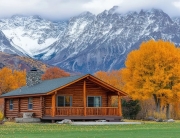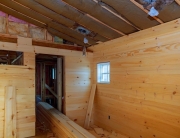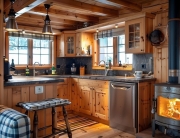Table of Contents
Choosing the best variety of wood for a log cabin for your climate is of paramount importance. The best all-around choice is colorful cedar found in Eastern U.S. lowlands and forests. This natural winner has been used for posts, fences, and outdoor structures for centuries for its enduring qualities.
Cedar makes the ideal material for log cabin siding both inside and out because:
- Its rustic beauty is timeless
- Cedar is highly moisture resistant
- Its insect resistance is amazing
- Cedar is a strong wood
- It has a low risk of warping and shrinking
Keep reading, and you will see why this durable and affordable wood is a favorite choice for log cabins and larger log homes.

Its Natural Beauty Is Difficult to Surpass
If beautiful wood is what you seek for a log cabin, you can’t go wrong with northern white cedar log siding. It is aesthetically attractive and its enduring qualities include:
- Its heartwood is pale brown or tan, and its sapwood is almost white in color.
- Cedar has numerous small knots scattered throughout logs.
- Its end grain is a medium contrast color compared to the sides of the log siding.
Don’t forget about the grain patterns that vary from straight to figured that also add a distinctive characteristic. Cedar can be further enhanced by staining and/or covering with a clear coat.
Cedar Is More Moisture Resistant Than Many Wood Varieties

If you’ve heard that eastern cedar is more moisture-resistant than many other wood varieties, you hear it right. This is an advantage when it is used for outdoor projects like furniture, fencing, and most especially log cabins. There are natural components that add moisture resistance:
- Its natural oils and acids, called polyphenols, help seal the wood grain and block out moisture.
- These components help prevent decay and insect infestation like termites which in turn also keeps water out.
- Since cedar is a stable and strong wood, it does not warp or shrink much that keeps it from cracking or splitting. This quality also keeps moisture out year-round.
Cedar is also a favorite wood for indoor saunas because it resists high humidity presence. If you’re looking for an ideal siding wood that can withstand the harshest of climates, cedar is a fantastic choice.
| “Choosing the best variety of wood for a log cabin for your climate is of paramount importance. The best all-around choice is colorful cedar found in Eastern U.S. lowlands and forests.” |
Cedar Log Siding Is More Insect Resistant Than Most Woods
Several different insects can damage wood by eating it or burrowing into it to make nests for their young. You can detect the presence of some of them by noticing sawdust on the wood’s surfaces. Damage caused by others isn’t visible to the naked eye and may go unnoticed.
The same polyphenols that make cedar moisture-resistant also keep insects away, such as:
Carpenter Ants Carpenter Bees Longhorned Beatles
Powderpost Beatles Termites
Using cedar log siding instead of another wood gives you a leg up on preserving a cabin’s walls.
This Wood Is Stronger Than Some Other Soft Woods
Cedar log siding is a durable choice over some other woods and its extra cost is well worth it. Although it is lightweight, it is very strong and an ideal exterior building material. This is one of the reasons so many farmers over the centuries used it for fence posts, fencing rails, shingles, and roofing. Boatbuilders also find that it’s an ideal material for long-term use.
Wood strength is measured by compression strength, bending strength, stiffness, and hardness. Cedar is not as strong as oak or maple but possesses these qualities enough for strong and durable log cabin siding.
There Is a Low Risk of Warping and Shrinking
Eastern cedar is dimensionally stable and resists warping, shrinking, and swelling for all the reasons given so far and also because it’s temperature resistant. Cedar is among the densest wood species which helps prevent cracking. Let us know your log cabin needs for siding, trim, corner systems, interior trim, flooring, and we will supply them.







Recent Comments